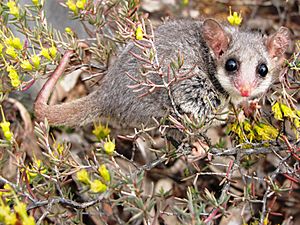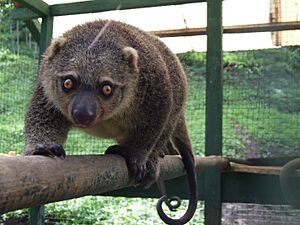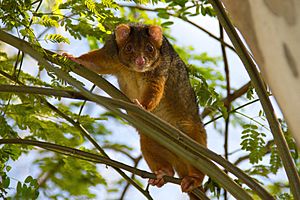Phalangeriformes facts for kids
Quick facts for kids Phalangeriformes
|
|
|---|---|
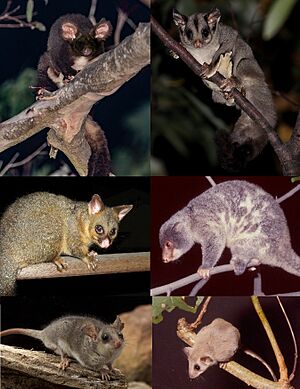 |
|
| Scientific classification | |
| Kingdom: | Animalia |
| Phylum: | Chordata |
| Class: | Mammalia |
| Infraclass: | Marsupialia |
| Order: | Diprotodontia |
| Suborder: | Phalangeriformes Szalay in Archer, 1982 |
| Groups included | |
|
|
| Cladistically included but traditionally excluded taxa | |
Phalangeriformes is a group of about 70 different kinds of small to medium-sized marsupials. These animals mostly live in trees, which means they are tree-dwelling. You can find them in places like Australia, New Guinea, and Sulawesi.
People often call these animals possums, gliders, or cuscus. The name "possum" sounds a lot like "opossum," which are marsupials found in the Americas. Even though they share a similar name and are both marsupials, Australasian possums are actually more closely related to other marsupials from their own region, like kangaroos.
These possums are four-legged animals with long tails. They are also "diprotodont," which means they have two large lower front teeth. The smallest of these animals is the Tasmanian pygmy possum. It's only about 70 millimeters (about 2.7 inches) long and weighs around 10 grams (less than half an ounce). The biggest ones are the two types of bear cuscus, which can weigh more than 7 kilograms (about 15 pounds).
Most Phalangeriformes are active at night and live partly or fully in trees. They live in many different places where there are plants, and some have even learned to live in cities. Their diets vary a lot. Some, like the common brushtail possum, eat many different things, including plants and insects. Others are very picky eaters, like the greater glider which mainly eats eucalyptus leaves. Some are insectivores (eat insects), and some, like the honey possum, drink nectar from flowers.
Contents
Types of Possums and Gliders
About two-thirds of Australia's marsupials belong to a larger group called the order Diprotodontia. This big group is split into three main parts:
- Vombatiformes: This includes wombats and the koala. There are only four species in this group.
- Phalangeriformes: This is the large and diverse group of possums and gliders we are learning about.
- Macropodiformes: This group includes kangaroos, potoroos, wallabies, and the musky rat-kangaroo.
Scientists are always learning more about how these animals are related. Sometimes, they find that the Phalangeriformes group might include the Macropodiformes group, meaning they are very closely linked.
Superfamily Phalangeroidea
This superfamily includes pygmy possums, brushtail possums, and cuscus.
Family Burramyidae: Pygmy Possums
These are tiny possums.
- Genus Burramys
- Mountain pygmy possum, B. parvus
- Genus Cercartetus
- Long-tailed pygmy possum, C. caudatus
- Southwestern pygmy possum, C. concinnus
- Tasmanian pygmy possum, C. lepidus
- Eastern pygmy possum, C. nanus
Family Phalangeridae: Brushtail Possums and Cuscuses
This family includes the well-known brushtail possums and the cuscus.
- Subfamily Ailuropinae
- Genus Ailurops
- Talaud bear cuscus, A. melanotis
- Sulawesi bear cuscus, A. ursinus
- Genus Strigocuscus
- Sulawesi dwarf cuscus, S. celebensis
- Banggai cuscus, S. pelegensis
- Genus Ailurops
- Subfamily Phalangerinae
- Tribe Phalangerini
- Genus Phalanger
- Gebe cuscus, P. alexandrae
- Mountain cuscus, P. carmelitae
- Ground cuscus, P. gymnotis
- Eastern common cuscus, P. intercastellanus
- Woodlark cuscus, P. lullulae
- Blue-eyed cuscus, P. matabiru
- Telefomin cuscus, P. matanim
- Southern common cuscus, P. mimicus
- Northern common cuscus, P. orientalis
- Ornate cuscus, P. ornatus
- Rothschild's cuscus, P. rothschildi
- Silky cuscus, P. sericeus
- Stein's cuscus, P. vestitus
- Genus Spilocuscus
- Admiralty Island cuscus, S. kraemeri
- Common spotted cuscus, S. maculatus
- Waigeou cuscus, S. papuensis
- Black-spotted cuscus, S. rufoniger
- Blue-eyed spotted cuscus, S. wilsoni
- Genus Phalanger
- Tribe Trichosurini
- Genus Trichosurus
- Northern brushtail possum, T. arnhemensis
- Short-eared possum, T. caninus
- Mountain brushtail possum, T. cunninghami
- Coppery brushtail possum, T. johnstonii
- Common brushtail possum, T. vulpecula
- Genus Wyulda
- Scaly-tailed possum, W. squamicaudata
- Genus Trichosurus
- Tribe Phalangerini
Superfamily Petauroidea
This superfamily includes ring-tailed possums, gliders, and the honey possum.
Family Pseudocheiridae: Ring-tailed Possums and Allies
These possums often have tails that can grip branches.
- Subfamily Hemibelideinae
- Genus Hemibelideus
- Lemur-like ringtail possum, H. lemuroides
- Genus Petauroides
- Central greater glider, P. armillatus
- Northern greater glider, P. minor
- Southern greater glider, P. volans
- Genus Hemibelideus
- Subfamily Pseudocheirinae
- Genus Petropseudes
- Rock-haunting ringtail possum, P. dahli
- Genus Pseudocheirus
- Common ringtail possum, P. peregrinus
- Genus Pseudochirulus
- Lowland ringtail possum, P. canescens
- Weyland ringtail possum, P. caroli
- Cinereus ringtail possum, P. cinereus
- Painted ringtail possum, P. forbesi
- Herbert River ringtail possum, P. herbertensis
- Masked ringtail possum, P. larvatus
- Pygmy ringtail possum, P. mayeri
- Vogelkop ringtail possum, P. schlegeli
- Genus Petropseudes
- Subfamily Pseudochiropsinae
- Genus Pseudochirops
- D'Albertis' ringtail possum, P. albertisii
- Green ringtail possum, P. archeri
- Plush-coated ringtail possum, P. corinnae
- Reclusive ringtail possum, P. coronatus
- Coppery ringtail possum, P. cupreus
- Genus Pseudochirops
Family Petauridae: Striped Possums and Gliders
This family includes many types of gliders, known for their ability to glide through the air.
- Genus Dactylopsila
- Great-tailed triok, D. megalura
- Long-fingered triok, D. palpator
- Tate's triok, D. tatei
- Striped possum, D. trivirgata
- Genus Gymnobelideus
- Leadbeater's possum, G. leadbeateri
- Genus Petaurus
- Northern glider, P. abidi
- Savanna glider, P. ariel
- Yellow-bellied glider, P. australis
- Biak glider, P. biacensis
- Sugar glider, P. breviceps
- Mahogany glider, P. gracilis
- Squirrel glider, P. norfolcensis
- Krefft's glider, P. notatus
Family Tarsipedidae: Honey Possum
This family has only one species, the honey possum.
- Genus Tarsipes
- Honey possum or noolbenger, T. rostratus
Family Acrobatidae: Feathertail Glider and Feather-tailed Possum
These are small, agile animals.
- Genus Acrobates
- Feathertail glider, A. pygmaeus
- Genus Distoechurus
- Feather-tailed possum, D. pennatus
Images for kids


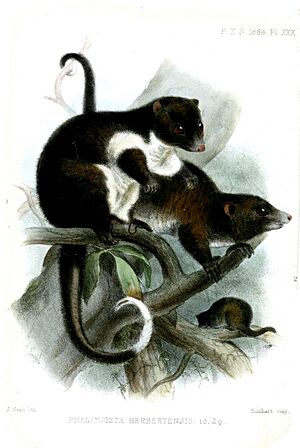
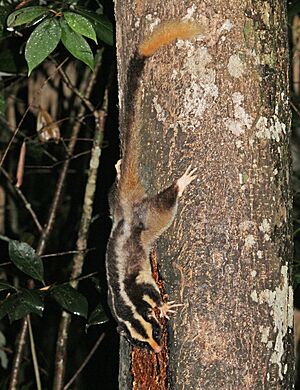
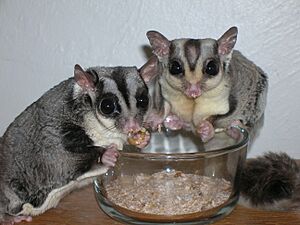

See also
 In Spanish: Phalangeriformes para niños
In Spanish: Phalangeriformes para niños


